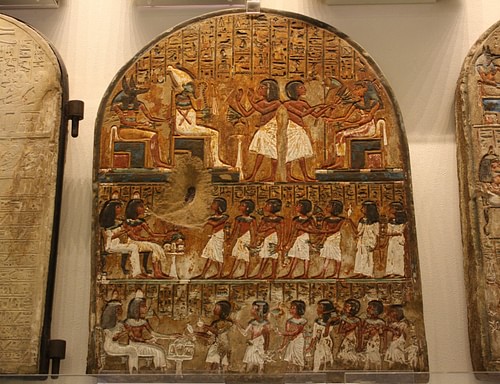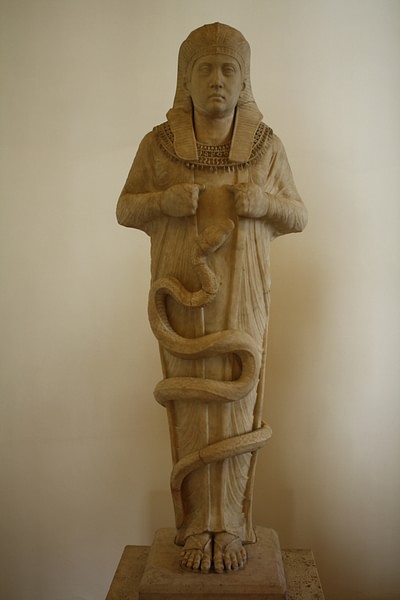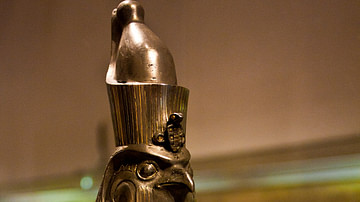
Osiris is the Egyptian Lord of the Underworld and Judge of the Dead, brother-husband to Isis, and one of the most important gods of ancient Egypt. The name `Osiris' is the Latinized form of the Egyptian Usir which is interpreted as 'powerful' or 'mighty'.
He is the first-born of the gods Geb (earth) and Nut (sky) shortly after the creation of the world, was murdered by his younger brother Set, and brought back to life by his sister-wife Isis. This myth, and the gods involved, became central to Egyptian culture and religious life. Osiris was originally a fertility god, possibly from Syria (though this claim is contested) who became so popular he absorbed the function of earlier gods such as Andjeti and Khentiamenti, two gods of fertility and agriculture worshipped at Abydos. He is associated with the djed symbol and is often depicted with black or green skin symbolizing the fertile mud of the Nile and regeneration. He is also frequently shown as a mummy or in partially mummified form in his role as Judge of the Dead.
Images of Osiris as a living god depict him as a handsome man in royal dress wearing the crown of Upper Egypt as a plumed headdress known as the atef and carrying the crook and flail, symbols of kingship. He is associated with the mythical Bennu bird (inspiration for the Greek Phoenix) who rises to life from the ashes. Osiris was known by many names but chiefly as Wennefer, "The Beautiful One" and, in his role as Judge of the Dead, Khentiamenti, "The Foremost of the Westerners". The west was associated with death and 'westerners' became synonymous with those who had passed on to the afterlife.
He was also known as The Lord of Love, King of the Living, and Eternal Lord. After Isis, Osiris was the most popular and enduring of all the Egyptian gods. His worship spanned thousands of years from shortly before the Early Dynastic Period (c. 3150-2613 BCE) to the Ptolemaic Dynasty (323-30 BCE), the last dynasty to rule Egypt before the coming of Rome. It is also possible that Osiris was worshipped in some form in the Predynastic Period of Egypt (c. 6000-3150 BCE) and probable that he originated at that time. Scholar Geraldine Pinch writes:
Where, when, and how Osiris was first worshipped is much disputed. It has been claimed that Osiris was originally a deified Predynastic king, a primitive vegetation spirit, a jackal god of an early royal necropolis, or a mother goddess. Even the etymology of his name is uncertain, though it may simply mean 'The Mighty One'. (178)
Although he is usually seen as a just, generous, and giving god of life and abundance there are also depictions of him as "a terrifying figure who dispatches demon-messengers to drag the living into the gloomy realm of the dead" (Pinch, 178) though these are the minority. Osiris as the kind and just ruler, murdered by his resentful brother, who comes back to life is the most popular and enduring image of the god.
The Osiris Myth
After the creation of the world, the first five gods were born of the union of Geb (earth) and Nut (sky) and these were Osiris, Isis, Set, Nephthys, and Horus. Osiris, as the first born, assumed rule as Lord of the Earth, with Isis as his queen and consort. He found the people of Egypt uncivilized and lawless and so gave them laws, culture, religious instruction, and agriculture. Egypt became a paradise under Osiris' rule where everyone was equal and there was abundant food as the crops were always plentiful.
Set was jealous of his brother's success and grew resentful. Their relationship deteriorated further after Nephthys, Set's wife, disguised herself as Isis and seduced Osiris, becoming pregnant with the god Anubis. Set had a beautiful coffin made to Osiris' exact height and then threw a grand party where he presented this box and told the guests that whichever of them fit in it most perfectly could have it as a gift. When Osiris lay down in the coffin, Set slammed the lid on, fastened it shut, and threw it into the Nile, where it was carried away down river.
Osiris' body traveled out to sea and eventually his coffin became lodged in a great tamarisk tree growing near Byblos in Phoenicia. The tree grew quickly around the coffin until it completely contained it. The king of Byblos, Malcander, came to the shore with his wife Astarte and admired the tree and the sweet scent which seemed to emanate from it. He ordered the tree cut down and brought to his palace as an ornamental pillar for the court, and there Osiris remained, trapped inside the coffin within the pillar, until he died.
Isis had meanwhile left Egypt in search of her husband and eventually came to Byblos, disguised as an older woman, where she sat down by the shore and cried for her missing husband. She was invited to the palace by the royal handmaidens who had come to the shore to bathe and there ingratiated herself to the king and queen so she was asked to be nursemaid for their young sons.
Isis tried to make the younger boy immortal by bathing him in fire and, when Queen Astarte discovered this, she was horrified. Isis then revealed herself as the goddess and the king and queen promised her anything she wanted if she would only spare them. She requested only the pillar - which they swiftly granted to her.
After leaving the court, Isis cut Osiris from the tree and carried his body back to Egypt where she hid him from Set in the swampy region of the Nile Delta. She left him to go gather herbs to make a potion to return him to life, leaving her sister Nephthys to guard the body. While she was gone, Set learned of his brother's return and went out to find his body. He managed to get Nephthys to tell him where it was, and when he found it, he hacked it into pieces and scattered it across the land and into the Nile.
When Isis returned, she was horrified but quickly composed herself and went to work finding the pieces of her murdered husband. With Nephthys' help, she recovered all of the body parts except the penis, which had been thrown into the Nile and eaten by the oxyrhyncus fish, which is why this fish was forbidden food in ancient Egypt.
Isis was able to revive Osiris and, once he was alive, she assumed the form of a kite and flew around him, drew the seed from his body into her own, and became pregnant with a son, Horus. Even though Osiris now lived, he was incomplete and could no longer rule the land of the living. He withdrew into the afterlife where he became Lord and Judge of the Dead.
Isis, fearing what Set might do to her son, hid Horus among the swamps of Egypt until he was grown. At that point, Horus emerged as a mighty warrior and battled Set for control of the world. In some versions of the story, Set is killed but, in most, he is defeated and driven from the land. The chaos Set had unleashed on the world was conquered by Horus, who restored order, and then ruled with his mother.
Worship of Osiris
The myth embodied some of the most important values of Egyptian culture: harmony, order, eternal life, and gratitude. Set's resentment of Osiris, even before the affair with Nepthys, grew from a lack of gratitude and an envy for someone else's good fortune. In Egypt, ingratitude was a kind of "gateway sin" which opened the individual up to all others. The story dramatically illustrated how even a god could fall prey to ingratitude and the consequences which could follow. Just as importantly, the myth told the story of the victory of order over chaos and the establishment of harmony in the land; a central value of Egyptian culture and religion.

Osiris' rebirth was associated with the Nile River, which was considered a symbol of his life-giving power. Osiris' festivals were held to celebrate the beauty of the god and his transcendent power but also his death and rebirth. The festival of the Fall of the Nile commemorated his death while the Djed Pillar Festival celebrated Osiris' resurrection. Historian Margaret Bunson writes:
As the Nile receeded, the Egyptians went to the shore to bestow gifts and to show grief over Osiris' dying another time. The Nile represented Osiris' capacity to renew the earth and to restore life to the nation. When the Nile began its steady rise toward the flood stage, Osiris was again honored. Small shrines were cast adrift on the river, and priests poured sweet water into the Nile, declaring that Osiris was found again. (198)
The city of Abydos was his cult center and the necropolis there became the most sought-after burial ground as people wanted to be buried as close to the god as they could get. Those who lived too far away or did not have the resources for such a burial had a stele erected there with their name on it. Osiris was most widely worshipped as Judge of the Dead but the 'dead' continued to exist in another realm and death was not the end of one's existence.
The festivals, therefore, celebrated life - both on earth and afterwards - and part of these celebrations was the planting of an Osiris Garden which was a garden bed molded in the shape of the god and fertilized by the mud and water of the Nile. The grains which would later grow symbolized Osiris rising from the dead and also the promise of eternal life for the one who tended the garden.
Osiris Gardens were placed in tombs where they are known as an Osiris' Bed. Margaret Bunson describes this practice, writing:
These were boxes fashioned out of wood or pottery normally in the shape of the god. Osiris' Beds were often hollow, planted with Nile mud and corn. The boxes were then wrapped as mummies and placed in the tomb. The corn was expected to sprout as a symbol of Osiris' resurrection. Some boxes did contain actual evidence of growth when they were unwrapped centuries later. (198)
Priests of Osiris tended the temple and statue of the god at Abydos, Busiris, and Heliopolis and, as was customary with Egyptian worship, the priests alone were allowed into the inner sanctum. The people of Egypt were invited to visit the temple complex to make offerings and ask for prayers, seek medical advice and counsel, receive aid from the priests by way of material goods or financial gifts, and leave sacrifices to the god in asking for a favor or by way of thanking the god for a request granted.
Osiris, the King, & the People
Osiris was considered the first king of Egypt who established the cultural values all later kings were sworn to uphold. When Set murdered the king, the country plunged into chaos and order was only restored with the victory of Horus over Set. The kings of Egypt identified with Horus during life (they each had a personal name and a 'Horus Name' they took at the beginning of their reign) and with Osiris in death. As Isis was the mother of Horus, she was considered the mother of every king, the king was her son, and Osiris was both their father and their higher aspect and hope of salvation after death.
It is for this reason that Osiris is so often depicted as a mummified pharaoh; because pharaohs were mummified to resemble Osiris. The image of the great mummified god preceeded the practice of preparing the royal body to look like Osiris. All the Egyptian symbols and images which made up the Pyramid Texts on the walls of tombs were meant to remind the soul of the deceased what to do next once they arrived in the afterlife. Their appearance as Osiris himself would not only remind them of the god but also would drive away dark spirits by fooling them into thinking one was the great god himself. The king's appearance as modeled after Osiris' extended throughout his reign; the famous flail and shepherd's staff, synonymous with Egyptian pharaohs, were first Osiris' symbols as the flail represented the fertility of his land while the crook symbolized the authority of his rule.
Harmony and order had been established by the son of Osiris, Horus, and the king was Horus' living representative who provided for the needs of the people. Osiris was credited with establishing both the kingship and the natural order and law of life and so, through one's participation in one's community and observance of rituals, one was following Osiris' guidelines. The people, as well as royalty, expected the protection of Osiris in life and his impartial judgment after death. Osiris was the all-merciful, the forgiving, and the just judge of the dead who oversaw one's life on earth and in the afterlife.
The Mysteries of Osiris
Osiris' identification with eternal life, with life from death, gave rise to his mystery cult which would travel beyond the boundaries of Egypt as the Cult of Isis. Although no one knows what rituals were involved in the mystery cult of Isis, they may have developed from Osiris' earlier mysteries celebrated at Abydos beginning in the Twelfth Dynasty (1991-1802 BCE). These were very popular festivals which drew people from all over Egypt to participate in the ritual. Bunson notes that "the mysteries recounted the life, death, mummification, resurrection, and ascension of Osiris" (198). Dramas were staged with the major roles given to prominent members of the community and the local priests who enacted the story of the Osiris myth. The call-and-response text known as The Lamentations of Isis and Nephthys, in which two women would play the roles of the goddesses calling Osiris back to life, was recited at the beginning of festivities.
The story known as The Contention Between Horus and Set was then acted out in mock battles between The Followers of Horus and The Followers of Set where it seems anyone could participate. Once the battle had been won by the followers of Horus, the people celebrated the restoration of order and the golden statue of Osiris was brought forth from the inner sanctum of the temple and carried among the people who lavished gifts upon the image. The statue was carried through the city in a circuit and finally placed in an outdoor shrine where he could be admired by his people and also participate fully in the festivities. The emergence of the god from the darkness of his temple to participation in the joys of the living symbolized Osiris' return to life from death.
Although this festival was primarily held at Abydos, it was also celebrated at other cult centers dedicated to Osiris throughout Egypt such as Bubastis (which was another very important cult center), Busiris, Memphis, and Thebes. Osiris, of course, was the central figure of these celebrations but, in time, the focus shifted to his wife, Isis, who had actually saved him from death and returned him to life. Osiris was intimately tied to the Nile River and the Nile River Valley of Egypt but Isis eventually became detached from any given locality and was considered the Queen of Heaven and the creator of the universe. All other Egyptian gods were finally seen as aspects of the mighy Isis and in this form her cult traveled to Greece, to Phoenicia, to Rome and throughout the Roman Empire.
The Cult of Isis was so popular in the Roman world that it outlasted every other pagan belief system once Christianity took hold of the popular imagination. The most profound aspects of Christianity, in fact, can be traced back to the worship of Osiris and the Cult of Isis which grew from his story. In ancient Egypt, as in the modern day, people needed to believe that there was a purpose to their lives, that death was not the end, and that some kind of supernatural being cared for them and would protect them. The worship of the great god Osiris provided for that need just as people's religious beliefs do today.







